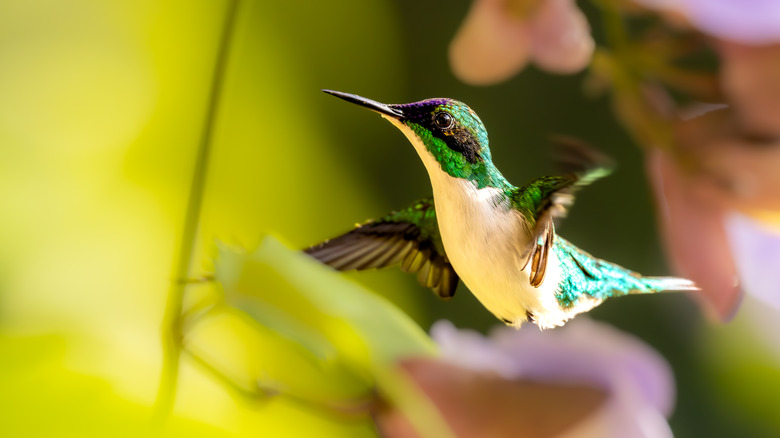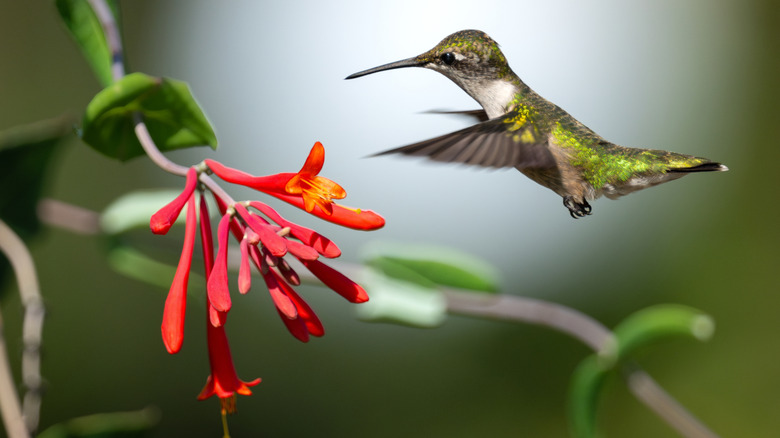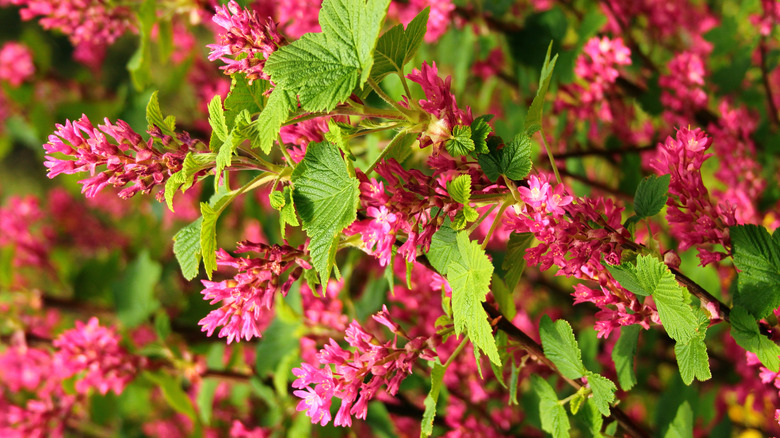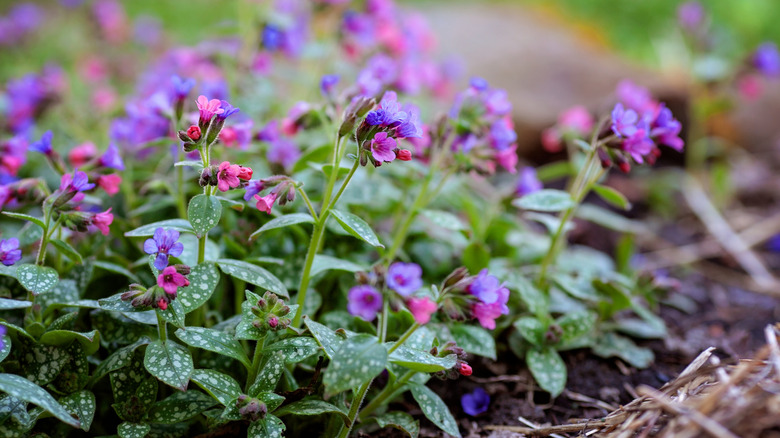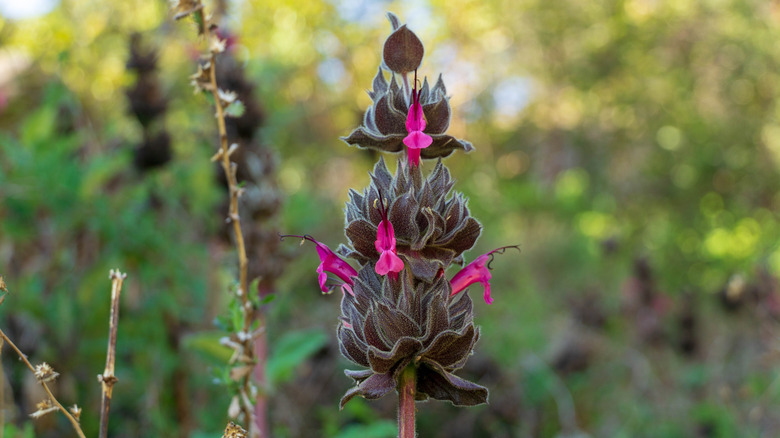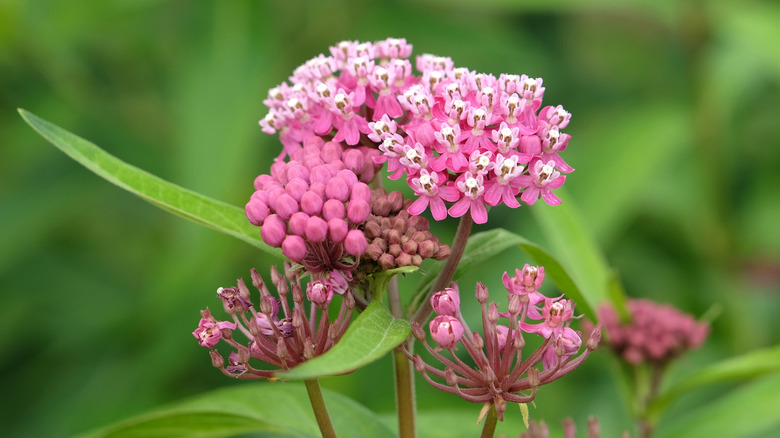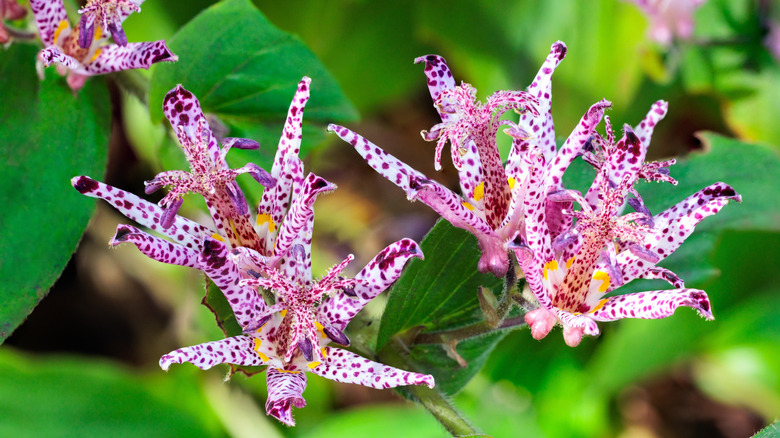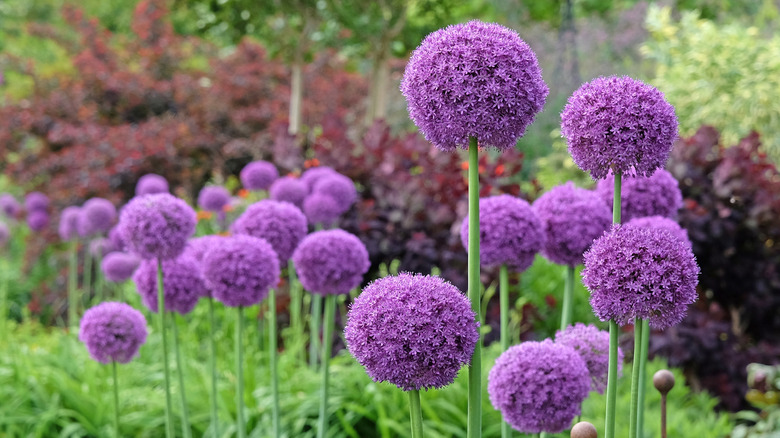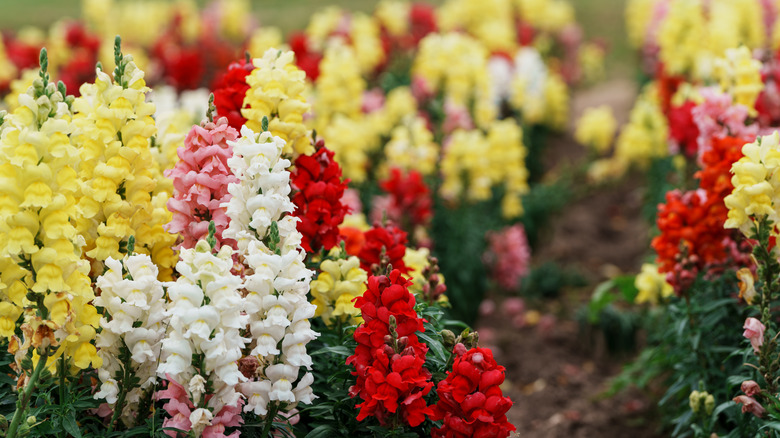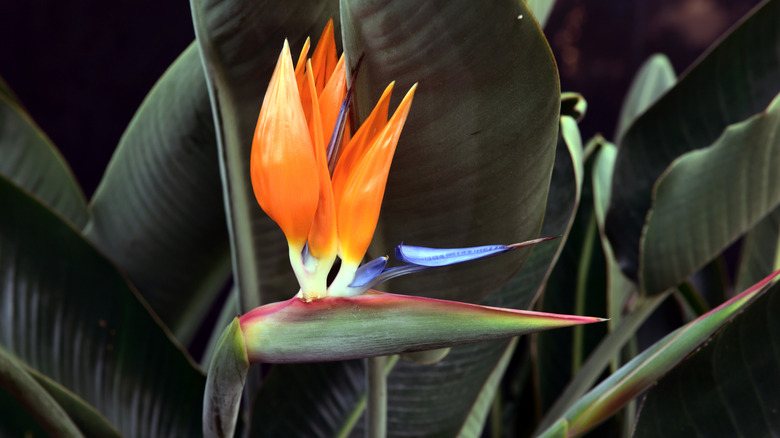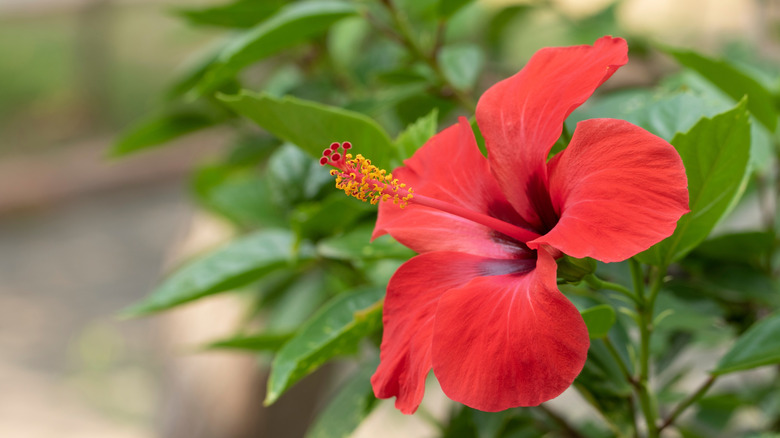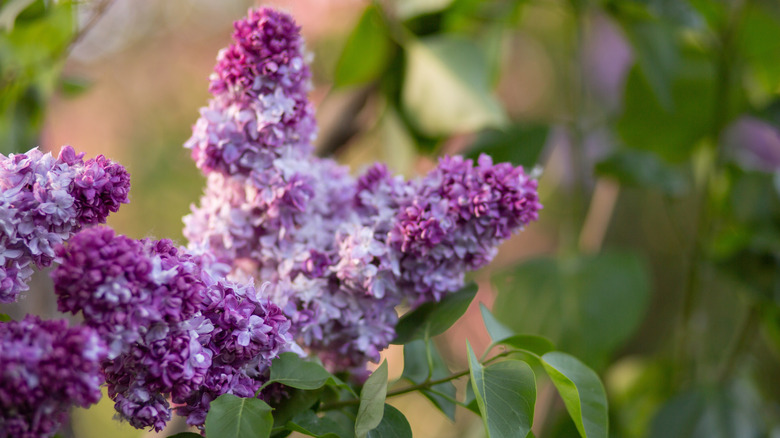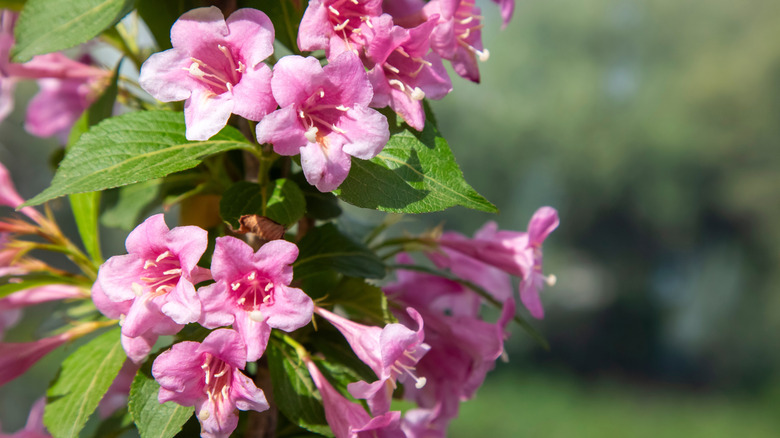12 Flowers That Will Transform Your Space Into A Hummingbird Heaven
Hummingbirds are a welcome visitor in just about any outdoor space. Whether you're attempting to attract more hummingbirds to your garden as a birdwatcher, looking to help out the local wildlife, or need more visiting pollinators to help fertilize your plants, there's nothing like seeing one of these little helpers stop by your garden for a drink. With that being said, you can't attract hummingbirds with any old garden setup. They don't eat seeds, so typical bird feeders won't do the job, and the average birdbath is too deep for tiny hummers to safely bathe and drink. Because of this, it's important to focus your attention on the resource they're actually seeking out: nectar.
There are plenty of nectar-producing flowers to choose from, but certain options, especially those with vibrant blooms, will act as a hummingbird magnet. Honeysuckles, red flowering currant, and lungwort fall into this category, along with many others, but if you want the best chances at success, consider diversifying your picks rather than simply sticking with one flower. A garden full of bright petals will be much more visible to birds passing by, and the variety could keep them coming back for more. If you want to go all-in, especially if your goal is to help out the environment, consider starting a pollinator garden with plants that will attract bees and butterflies as well. A garden full of color might be what hummingbirds are looking for, but you're sure to enjoy the vibrant view as well.
Honeysuckle
If you're looking for a plant that's sure to impress flying visitors like bees, butterflies, and, of course, hummingbirds, consider adding honeysuckle (Lonicera sempervirens) to your garden. These vining plants are hardy in USDA zones 4 to 9 and perfect to cover a fence or trellis in vibrant blooms, but they can also be used as a sprawling ground cover if you're looking to take up horizontal space. Unfortunately, some varieties can be hyper aggressive growers, so make sure you know how to tell if the honeysuckle in your yard is native or invasive before you plant.
Red flowering currant
Red flowering currant (Ribes sanguineum) is an especially beneficial flower to include in your hummingbird garden thanks to its early bloom time. While many hummingbird fan-favorite flowers reach their peak in late spring or summer, red flowering currant explodes into vibrant color in early spring, acting as a much-needed food source after a cold winter. This plant thrives in sunny areas, can tolerate drought, and is hardy in USDA zones 6 through 8. It even produces bright red berries in the summertime, providing an additional snack for, and helping to attract, other types of visiting birds.
Lungwort
You might not think that a plant with such an off-putting name would provide much aesthetic appeal, but it's important not to judge a book by its cover. Lungwort (Pulmonaria longifolia) is a gorgeous plant to include in your landscaping, even when it's not in bloom. Of course, hummingbirds love its vibrant purple flowers that pop up in spring, but gardeners looking for unique foliage will also likely find charm in its dark green leaves flecked with white blotches. If you live within USDA zones 3 through 8, this flowering plant is a perfect pick for the shady spots in your garden.
Hummingbird sage
As the name implies, hummingbird sage (Salvia spathacea) is a favorite for these pollinators. While they might not look all that vibrant from afar, these uniquely shaped plants grow up to 3 feet tall and are accented with large pink flowers at the tip of the stem. Native to California, these flowers are hardy in zones 8 through 11, and as long as the temperatures don't dip too low, they'll thrive with little need for water. Because they grow so tall, these flowers can stun as a way to add some height along the back of your beds.
Swamp milkweed
Swamp milkweed (Asclepias incarnata) might be better known as a butterfly-attracting plant, but its showy, dazzling blooms are hit with hummingbirds, too. This flower will do well in USDA hardiness zones 3 through 9, but it may not be the best pick if you live in a dry area. Milkweed thrives in wet, even swampy, soil (hence the name), so it's a better option for those who face frequent rainy conditions and don't want to have to jump through hoops to ensure their plants are getting adequate drainage.
Toad lily
Toad lily (Tricyrtis formosana) is a unique flower that will have your neighbors staring once it blooms in late summer or early autumn. Even the shape of the bloom itself — a star-shaped arrangement of petals and tepals that has a distinct, spiky look — can dazzle, but the star of the show is the white petals speckled with vibrant reddish purple dots. These flowers do well in USDA zones 4 to 9, prefer light shade, and are great for attracting hummingbirds thanks to the three large nectaries that can be found at the base of the flower.
Ornamental onion
Ornamental onion (Allium) looks like something straight out of a Dr. Seuss book, but its unique, rounded blooms will do more than just add a touch of fantasy to your garden. These bright or pastel purple flowers will do well in USDA zones 4 through 9 with light sun and good drainage, and they're a fantastic choice for attracting pollinators, including hummingbirds. Once the blooms begin to fade and they start dropping seeds, they'll also act as an attractive food source for visiting songbirds.
Snapdragon
Snapdragons (Antirrhinum majus) are a very popular and well-loved flower, both for growing in the garden and displaying cut in a bouquet. This isn't particularly surprising once you catch a glimpse of their large, showy blooms can that last from spring to autumn. These flowers are a hit with both butterflies and hummingbirds, making them a great choice for a pollinator garden, and will do well cultivated as an annual in USDA zones 7 through 10. Because they're so popular, you also have plenty of color options to choose from, ranging from delicate pastels to bold, multicolored blooms.
Bird-of-paradise
Bird-of-paradise (Strelitizia reginae) boasts one of the most uniquely shaped blooms out there, helping to add a pop of tropical interest to your garden. Pollinators seem to agree with its aesthetic appeal — this bird-like flower attracts hummingbirds thanks to its showy flowering head and easily accessible nectar. While you likely won't be able to grow bird-of-paradise outdoors if you live in an area with chilly winters, this plant is a great choice for those in USDA zones 10 through 12. If you ensure that it's kept healthy, you'll be rewarded with flowers popping up throughout the year.
Chinese hibiscus
Chinese hibiscus (Hibiscus rosa-sinensis) is commonly associated with tropical locales, so it's no surprise this flowering shrub will thrive in USDA zones 9 through 11. If you have the mild winters to support it, however, this plant's large, showy flowers can act as a hummingbird magnet. Make sure the shrub has plenty of sun and well-draining, moist soil, and you'll be rewarded with blooms that appear throughout spring, summer, and fall. While these flowers won't last long (just one day, for that matter), they'll quickly be replaced by the next bloom.
Lilac
Lilac (Syringa vulgaris) is well-known for its sweet scent, quick growth, and large, purple blooms, which hummingbirds love to visit. It thrives in USDA zones 3 through 7, and it's a great choice to quickly fill a large space in your garden. With that being said, some varieties of lilac are considered invasive, so it's important to be fully aware of what you're planting. Japanese tree lilac (Syringa reticulata) looks very similar to common lilac, but it has a much more aggressive growing habit that can allow it to escape cultivation and spread unintentionally, damaging the local ecosystem.
Weigela
Weigela (Weigela florida) is a low-maintenance plant that can act as a perfect pick for a hummingbird garden. It does well in USDA zones 4 through 8, and its trumpet-shaped blooms, which can be white, pink, or red depending on the cultivar, are just what hummingbirds are looking for when they stop off for a drink of nectar. It can tolerate a wide range of soils and conditions and doesn't require much work to thrive, so it's a great option for beginner gardeners or those who want a more hands-off approach.
